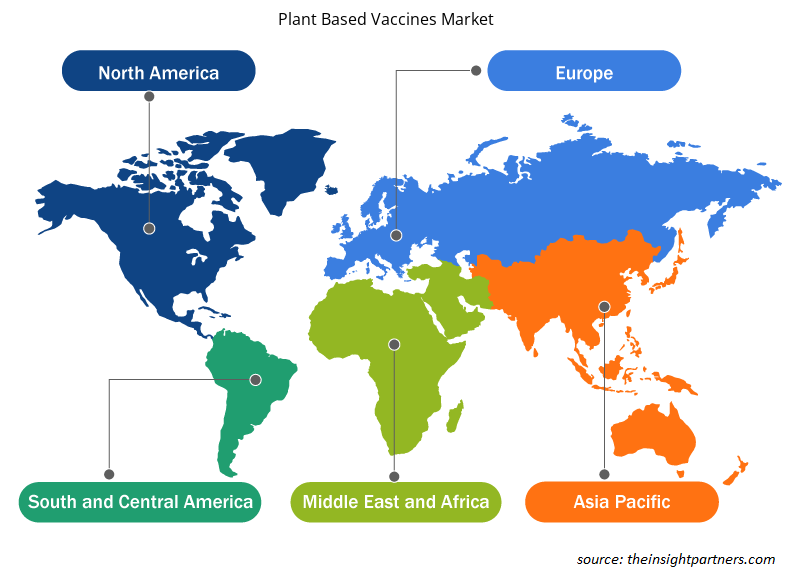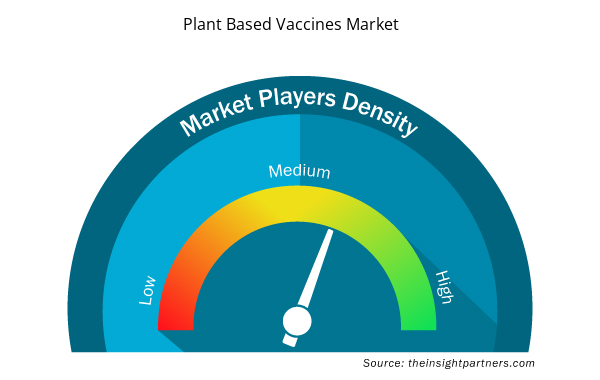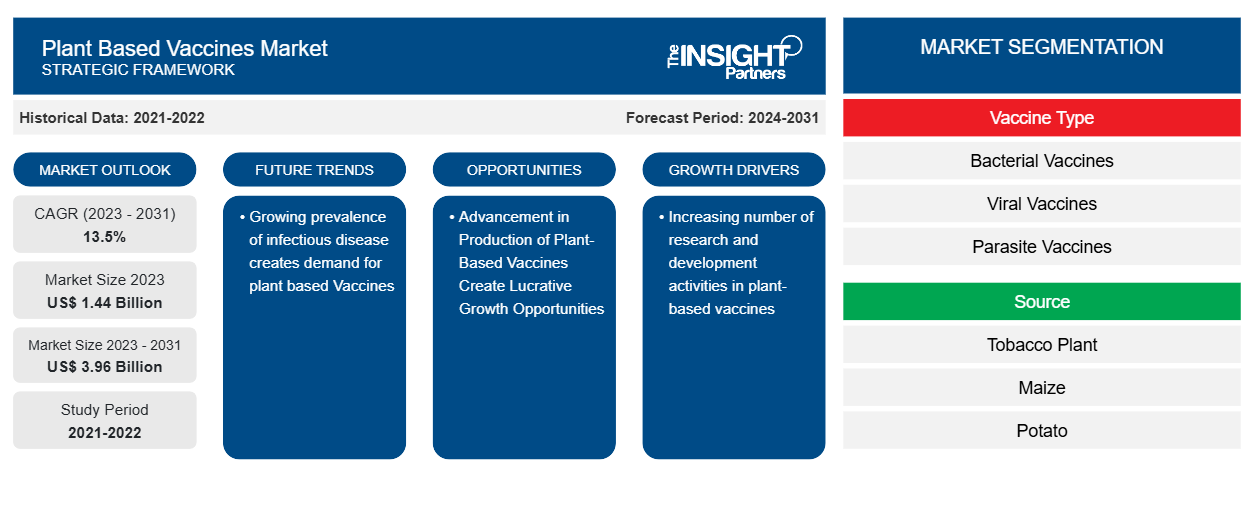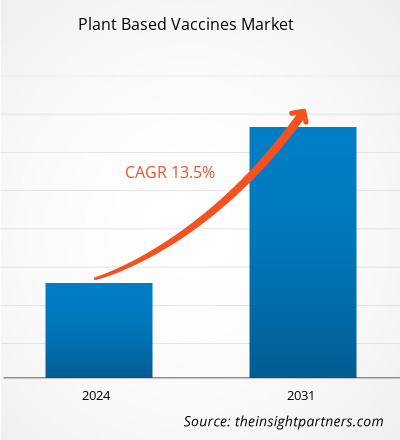Der Markt für pflanzliche Impfstoffe soll von 1,44 Milliarden US-Dollar im Jahr 2023 auf 3,96 Milliarden US-Dollar im Jahr 2031 anwachsen. Für den Zeitraum 2023–2031 wird ein durchschnittliches jährliches Wachstum von 13,5 % erwartet. Zunehmende Produkteinführungen und Produktzulassungen werden voraussichtlich weiterhin wichtige Trends auf dem Markt bleiben.
Marktanalyse für pflanzliche Impfstoffe
Die zunehmende Zahl von Forschungs- und Entwicklungsaktivitäten im Bereich pflanzlicher Impfstoffe führt zu Produktzulassungen und -einführungen, und die zunehmende Verbreitung von Infektionskrankheiten dürfte das Wachstum des Marktes für pflanzliche Impfstoffe vorantreiben. Darüber hinaus dürften zunehmende Finanzierungen und technologische Fortschritte bei Forschungsaktivitäten zum Marktwachstum beitragen. Darüber hinaus dürften Fortschritte bei der Herstellung pflanzlicher Impfstoffe wie Gentransfer durch Agrobacterium und Transformation durch ein gentechnisch verändertes Pflanzenvirus, zwei typische Ansätze zur Herstellung wirksamer Impfstoffe, in den kommenden Jahren reichlich Gelegenheiten schaffen.
Marktübersicht für pflanzliche Impfstoffe
Die zunehmende Zahl von Forschungs- und Entwicklungsaktivitäten im Bereich pflanzlicher Impfstoffe führt zu Produktzulassungen und -einführungen, und die zunehmende Verbreitung von Infektionskrankheiten dürfte das Wachstum des Marktes für pflanzliche Impfstoffe vorantreiben. Darüber hinaus wird Nordamerika im Jahr 2023 aufgrund der steigenden Zahl von Produkteinführungen, Produktzulassungen sowie der Steigerung der Forschungs- und Entwicklungsaktivitäten den größten Marktanteil haben. Europa ist nach Nordamerika die zweitgrößte Region, und der asiatisch-pazifische Raum dürfte aufgrund der zunehmenden Entwicklung von Forschungsstudien und der zunehmenden Verbreitung von Infektionskrankheiten, die den Bedarf am Markt für pflanzliche Impfstoffe in die Höhe getrieben haben, ein erhebliches Wachstum verzeichnen. Länder wie Australien, Indien und Südkorea werden voraussichtlich aufgrund der zunehmenden Entwicklung im Pharmasektor verschiedene Wachstumschancen bieten, was die Faktoren sind, die zum Marktwachstum beitragen.
Passen Sie diesen Bericht Ihren Anforderungen an
Sie erhalten kostenlos individuelle Anpassungen an jedem Bericht, einschließlich Teilen dieses Berichts oder einer Analyse auf Länderebene, eines Excel-Datenpakets sowie tolle Angebote und Rabatte für Start-ups und Universitäten.
- Holen Sie sich die wichtigsten Markttrends aus diesem Bericht.Dieses KOSTENLOSE Beispiel umfasst eine Datenanalyse von Markttrends bis hin zu Schätzungen und Prognosen.
Markttreiber und Chancen für pflanzliche Impfstoffe
Zunehmende Verbreitung von Infektionskrankheiten begünstigt den Markt
Die steigende Verbreitung von Infektionskrankheiten wie COVID-19, Grippe, Erkältung, Tuberkulose (TB), Hepatitis A und B wird im Prognosezeitraum voraussichtlich die Nachfrage nach pflanzlichen Impfstoffen ansteigen lassen. Am 31. Dezember 2019 wurde in Wuhan, China, erstmals ein COVID-19-Fall festgestellt. Am 11. März 2020 erklärte die Weltgesundheitsorganisation COVID-19 zur Pandemie. Die rasante Verbreitung von COVID-19 stellt die Gesundheitssysteme weltweit vor Herausforderungen. In vielen Ländern sind Krankenhäuser und Intensivstationen überlastet oder stehen kurz vor dem Kollaps. Daher ist ein möglichst effizienter Einsatz der Gesundheitsressourcen erforderlich. Da nur eingeschränkter Zugang zu Atemgeräten, qualifiziertem Intensivpflegepersonal oder geschützten Patientenüberwachungssystemen besteht, sind die Gesundheitsdienstleister gezwungen, schwer kranke Patienten zu behandeln. Der Aufwand, um zu verhindern, dass sich der Zustand von COVID-19-Patienten verschlechtert und sie auf die Intensivstation eingeliefert werden, ist enorm. Um die Ausbreitung des SARS-CoV-2-Virus zu verlangsamen und künftige Ausbrüche zu verhindern, besteht ein hoher Bedarf an neuen Diagnostik-, Behandlungs- und Impfstoffen.
Fortschritte bei der Produktion pflanzlicher Impfstoffe
Bei der pflanzenbasierten Impftechnologie werden verschiedene Ansätze verwendet, um die gewünschten Gene, die das Antigenprotein für eine bestimmte Krankheit kodieren, in das Genom von Pflanzengewebe zu integrieren. Gentransfer durch Agrobacterium und Transformation durch ein gentechnisch verändertes Pflanzenvirus sind zwei typische Ansätze zur Herstellung wirksamer Impfstoffe. Mit dem Fortschritt von Wissenschaft und Technologie wurden jedoch neue Ansätze entwickelt, um die Effizienz älterer Technologien zu verbessern, darunter Biolistik, Elektroporation, Agroinfiltration, Beschallung und Polyethylenglykolbehandlung. Wenn mikrobielle Gene in das Pflanzengenom eingebaut werden, werden sie in Zielproteinantigene des Pathogens übersetzt, ohne die Pflanze zu schädigen oder ihre Immunogenität zu verlieren. Die systemischen und mukosalen Immunreaktionen sind an der Initiierung der Immunität des Wirts gegen die Infektion beteiligt. Einige Impfstoffe, wie Cholera, Lyme-Borreliose, Milzbrand, Tetanus, Pest, Rotavirus und Hundeparvovirus, werden mit Direktbombardierung oder biolistischen Methoden hergestellt. Impfstoffe gegen Tuberkulose, Dengue-Fieber, Vogelgrippe und Ebola wurden mithilfe indirekter Methoden oder eines Agrobacterium-vermittelten Gentransfers entwickelt.
Marktbericht zu pflanzlichen Impfstoffen – Segmentierungsanalyse
Wichtige Segmente, die zur Ableitung der Marktanalyse für pflanzliche Impfstoffe beigetragen haben, sind Impfstofftyp, -quelle und -anwendung.
- Basierend auf dem Impfstofftyp ist der Markt für pflanzliche Impfstoffe segmentiert in bakterielle Impfstoffe, virale Impfstoffe, Parasitenimpfstoffe, pflanzliche virusähnliche Partikel (VLPS) und andere. Das Segment der bakteriellen Impfstoffe hatte im Jahr 2023 den größten Marktanteil.
- Nach Quelle ist der Markt in Tabakpflanzen, Mais, Kartoffeln und andere unterteilt. Das Segment Tabakpflanzen hatte im Jahr 2023 den größten Marktanteil.
- In Bezug auf die Anwendung wird der Markt in Grippe, Zika-Virus, Ebola-Virus, Geflügelkrankheit, Covid-19 und andere unterteilt. Das Grippesegment hielt im Jahr 2023 einen erheblichen Marktanteil.
Marktanteilsanalyse für pflanzliche Impfstoffe nach Geografie
Der geografische Umfang des Marktberichts über pflanzliche Impfstoffe ist hauptsächlich in fünf Regionen unterteilt: Nordamerika, Asien-Pazifik, Europa, Naher Osten und Afrika sowie Süd- und Mittelamerika.
Nordamerika dominiert den Markt aufgrund der steigenden Anzahl von Produkteinführungen sowie der Forschungs- und Entwicklungsaktivitäten. Im Prognosezeitraum dürfte der Markt jedoch durch Faktoren wie Herausforderungen im Zusammenhang mit der Produktzulassung sowie Kontaminations- und Umweltrisiken bei der Herstellung pflanzlicher Impfstoffe gebremst werden. Die USA sind der weltweit größte Markt für pflanzliche Impfstoffe. Das Wachstum des Marktes ist auf die enorme Anzahl von F&E-Aktivitäten im Bereich pflanzlicher Impfstoffe zurückzuführen, die im Land durchgeführt werden. Die steigende Verbreitung von Infektionskrankheiten in dieser Region dürfte die Nachfrage nach pflanzlichen Impfstoffen ankurbeln. Infektionen wie Virushepatitis, Grippe und Tuberkulose (TB) gehören weiterhin zu den Hauptursachen für Krankheiten und Todesfälle in den Vereinigten Staaten, was zu erheblichen Ausgaben für infektionsbedingte Komplikationen führt. Der asiatisch-pazifische Raum wird in den kommenden Jahren voraussichtlich mit der höchsten durchschnittlichen jährlichen Wachstumsrate wachsen.
Regionale Einblicke in den Markt für pflanzliche Impfstoffe
Die regionalen Trends und Faktoren, die den Markt für pflanzliche Impfstoffe im Prognosezeitraum beeinflussen, wurden von den Analysten von Insight Partners ausführlich erläutert. In diesem Abschnitt werden auch die Marktsegmente und die Geografie für pflanzliche Impfstoffe in Nordamerika, Europa, im asiatisch-pazifischen Raum, im Nahen Osten und Afrika sowie in Süd- und Mittelamerika erörtert.

- Erhalten Sie regionale Daten zum Markt für pflanzliche Impfstoffe
Umfang des Marktberichts über pflanzliche Impfstoffe
| Berichtsattribut | Details |
|---|---|
| Marktgröße im Jahr 2023 | 1,44 Milliarden US-Dollar |
| Marktgröße bis 2031 | 3,96 Milliarden US-Dollar |
| Globale CAGR (2023 - 2031) | 13,5 % |
| Historische Daten | 2021-2022 |
| Prognosezeitraum | 2024–2031 |
| Abgedeckte Segmente | Nach Impfstofftyp
|
| Abgedeckte Regionen und Länder | Nordamerika
|
| Marktführer und wichtige Unternehmensprofile |
|
Marktteilnehmerdichte für pflanzliche Impfstoffe: Auswirkungen auf die Geschäftsdynamik verstehen
Der Markt für pflanzliche Impfstoffe wächst rasant, angetrieben durch die steigende Nachfrage der Endverbraucher aufgrund von Faktoren wie sich entwickelnden Verbraucherpräferenzen, technologischen Fortschritten und einem größeren Bewusstsein für die Vorteile des Produkts. Mit steigender Nachfrage erweitern Unternehmen ihr Angebot, entwickeln Innovationen, um die Bedürfnisse der Verbraucher zu erfüllen, und nutzen neue Trends, was das Marktwachstum weiter ankurbelt.
Die Marktteilnehmerdichte bezieht sich auf die Verteilung von Firmen oder Unternehmen, die in einem bestimmten Markt oder einer bestimmten Branche tätig sind. Sie gibt an, wie viele Wettbewerber (Marktteilnehmer) in einem bestimmten Marktraum im Verhältnis zu seiner Größe oder seinem gesamten Marktwert präsent sind.
Die wichtigsten auf dem Markt für pflanzliche Impfstoffe tätigen Unternehmen sind:
- MEDICAGO INC.
- British American Tobacco plc
- ICON GENETICS GMBH
- CREATIVE BIOLABS, INC.
- iBio, Inc.
- LENIOBIO
Haftungsausschluss : Die oben aufgeführten Unternehmen sind nicht in einer bestimmten Reihenfolge aufgeführt.

- Überblick über die wichtigsten Akteure auf dem Markt für pflanzliche Impfstoffe
Marktnachrichten und aktuelle Entwicklungen zu pflanzlichen Impfstoffen
Der Markt für pflanzliche Impfstoffe wird durch die Erhebung qualitativer und quantitativer Daten aus Primär- und Sekundärforschung bewertet, die wichtige Unternehmensveröffentlichungen, Verbandsdaten und Datenbanken umfasst. Nachfolgend sind einige der Entwicklungen auf dem Markt für pflanzliche Impfstoffe aufgeführt:
- Medicago und GlaxoSmithKline (GSK) haben bekannt gegeben, dass Health Canada die Zulassung für den COVID-19-Impfstoff COVIFENZ (pflanzliche virusähnliche Partikel [VLP], rekombinant, adjuvantiert) erteilt hat. Dieser Impfstoff ist zur aktiven Immunisierung zur Vorbeugung der Coronavirus-Krankheit 2019 (COVID-19), die durch das schwere akute respiratorische Syndrom Coronavirus 2 (SARS-CoV-2) verursacht wird, bei Personen im Alter von 18 bis 64 Jahren vorgesehen. (Quelle: GlaxoSmithKline, Pressemitteilung, Februar 2022)
- CEPI stellt LenioBio Finanzmittel in Höhe von bis zu 2 Millionen US-Dollar zur Verfügung, um einen präklinischen Proof of Concept zu erbringen, dass eine kommerziell erhältliche, pflanzliche und zellfreie Technologie Proteine produzieren kann, die in 20-40 Tagen in Impfstoffversuchen gegen Epidemien und Pandemien eingesetzt werden können. Ziel ist es, mithilfe der ALiCE-Technologie von LenioBio die Zeit zu verkürzen, die für die Herstellung von Impfstoffproteinen mit „traditionelleren Methoden“ wie Zellkulturen erforderlich ist. (Quelle: CEPI, Newsletter, Mai 2024)
Marktbericht zu pflanzlichen Impfstoffen – Umfang und Ergebnisse
Der Bericht „Marktgröße und Prognose für Impfstoffe auf pflanzlicher Basis (2021–2031)“ bietet eine detaillierte Analyse des Marktes, die die folgenden Bereiche abdeckt:
- Marktgröße und Prognose für pflanzliche Impfstoffe auf globaler, regionaler und Länderebene für alle wichtigen Marktsegmente, die im Rahmen des Projekts abgedeckt sind
- Markttrends für pflanzliche Impfstoffe sowie Marktdynamiken wie Treiber, Hemmnisse und wichtige Chancen
- Detaillierte PEST/Porters Five Forces- und SWOT-Analyse
- Marktanalyse für pflanzliche Impfstoffe mit Blick auf wichtige Markttrends, globale und regionale Rahmenbedingungen, wichtige Akteure, Vorschriften und aktuelle Marktentwicklungen
- Branchenlandschaft und Wettbewerbsanalyse, die die Marktkonzentration, Heatmap-Analyse, prominente Akteure und aktuelle Entwicklungen für den Markt für pflanzliche Impfstoffe umfasst
- Detaillierte Firmenprofile
- Historische Analyse (2 Jahre), Basisjahr, Prognose (7 Jahre) mit CAGR
- PEST- und SWOT-Analyse
- Marktgröße Wert/Volumen – Global, Regional, Land
- Branche und Wettbewerbsumfeld
- Excel-Datensatz


- Broth Market
- Europe Surety Market
- Rugged Servers Market
- Integrated Platform Management System Market
- Non-Emergency Medical Transportation Market
- Animal Genetics Market
- Advanced Planning and Scheduling Software Market
- Print Management Software Market
- Space Situational Awareness (SSA) Market
- Sweet Potato Market

Report Coverage
Revenue forecast, Company Analysis, Industry landscape, Growth factors, and Trends

Segment Covered
This text is related
to segments covered.

Regional Scope
North America, Europe, Asia Pacific, Middle East & Africa, South & Central America

Country Scope
This text is related
to country scope.
Häufig gestellte Fragen
North America region dominated the Plant based vaccines market in 2023
Increasing number of research and development activities in plant-based vaccines leads to product approval and launches along with growing prevalence of infectious disease are the driving factors impacting the Plant based vaccines market
Increasing product launches and product approvals are the future trends of the Plant based vaccines market
The leading players operating in the Plant based vaccines market includes MEDICAGO, INC., British American Tobacco p.l.c., ICON GENETICS GMBH, CREATIVE BIOLABS, INC., iBio, Inc., LENIOBIO, Lumen Bioscience, Inc., LEAF EXPRESSION SYSTEMS LTD., ZYUS LIFE SCIENCES INC., FRAUNHOFER CMB
The estimated value of the Plant based vaccines market by 2031 is US$ 3.96 Bn
The expected CAGR of the Plant based vaccines market is 13.5%
Trends and growth analysis reports related to Life Sciences : READ MORE..
The Insight Partners performs research in 4 major stages: Data Collection & Secondary Research, Primary Research, Data Analysis and Data Triangulation & Final Review.
- Data Collection and Secondary Research:
As a market research and consulting firm operating from a decade, we have published and advised several client across the globe. First step for any study will start with an assessment of currently available data and insights from existing reports. Further, historical and current market information is collected from Investor Presentations, Annual Reports, SEC Filings, etc., and other information related to company’s performance and market positioning are gathered from Paid Databases (Factiva, Hoovers, and Reuters) and various other publications available in public domain.
Several associations trade associates, technical forums, institutes, societies and organization are accessed to gain technical as well as market related insights through their publications such as research papers, blogs and press releases related to the studies are referred to get cues about the market. Further, white papers, journals, magazines, and other news articles published in last 3 years are scrutinized and analyzed to understand the current market trends.
- Primary Research:
The primarily interview analysis comprise of data obtained from industry participants interview and answers to survey questions gathered by in-house primary team.
For primary research, interviews are conducted with industry experts/CEOs/Marketing Managers/VPs/Subject Matter Experts from both demand and supply side to get a 360-degree view of the market. The primary team conducts several interviews based on the complexity of the markets to understand the various market trends and dynamics which makes research more credible and precise.
A typical research interview fulfils the following functions:
- Provides first-hand information on the market size, market trends, growth trends, competitive landscape, and outlook
- Validates and strengthens in-house secondary research findings
- Develops the analysis team’s expertise and market understanding
Primary research involves email interactions and telephone interviews for each market, category, segment, and sub-segment across geographies. The participants who typically take part in such a process include, but are not limited to:
- Industry participants: VPs, business development managers, market intelligence managers and national sales managers
- Outside experts: Valuation experts, research analysts and key opinion leaders specializing in the electronics and semiconductor industry.
Below is the breakup of our primary respondents by company, designation, and region:

Once we receive the confirmation from primary research sources or primary respondents, we finalize the base year market estimation and forecast the data as per the macroeconomic and microeconomic factors assessed during data collection.
- Data Analysis:
Once data is validated through both secondary as well as primary respondents, we finalize the market estimations by hypothesis formulation and factor analysis at regional and country level.
- Macro-Economic Factor Analysis:
We analyse macroeconomic indicators such the gross domestic product (GDP), increase in the demand for goods and services across industries, technological advancement, regional economic growth, governmental policies, the influence of COVID-19, PEST analysis, and other aspects. This analysis aids in setting benchmarks for various nations/regions and approximating market splits. Additionally, the general trend of the aforementioned components aid in determining the market's development possibilities.
- Country Level Data:
Various factors that are especially aligned to the country are taken into account to determine the market size for a certain area and country, including the presence of vendors, such as headquarters and offices, the country's GDP, demand patterns, and industry growth. To comprehend the market dynamics for the nation, a number of growth variables, inhibitors, application areas, and current market trends are researched. The aforementioned elements aid in determining the country's overall market's growth potential.
- Company Profile:
The “Table of Contents” is formulated by listing and analyzing more than 25 - 30 companies operating in the market ecosystem across geographies. However, we profile only 10 companies as a standard practice in our syndicate reports. These 10 companies comprise leading, emerging, and regional players. Nonetheless, our analysis is not restricted to the 10 listed companies, we also analyze other companies present in the market to develop a holistic view and understand the prevailing trends. The “Company Profiles” section in the report covers key facts, business description, products & services, financial information, SWOT analysis, and key developments. The financial information presented is extracted from the annual reports and official documents of the publicly listed companies. Upon collecting the information for the sections of respective companies, we verify them via various primary sources and then compile the data in respective company profiles. The company level information helps us in deriving the base number as well as in forecasting the market size.
- Developing Base Number:
Aggregation of sales statistics (2020-2022) and macro-economic factor, and other secondary and primary research insights are utilized to arrive at base number and related market shares for 2022. The data gaps are identified in this step and relevant market data is analyzed, collected from paid primary interviews or databases. On finalizing the base year market size, forecasts are developed on the basis of macro-economic, industry and market growth factors and company level analysis.
- Data Triangulation and Final Review:
The market findings and base year market size calculations are validated from supply as well as demand side. Demand side validations are based on macro-economic factor analysis and benchmarks for respective regions and countries. In case of supply side validations, revenues of major companies are estimated (in case not available) based on industry benchmark, approximate number of employees, product portfolio, and primary interviews revenues are gathered. Further revenue from target product/service segment is assessed to avoid overshooting of market statistics. In case of heavy deviations between supply and demand side values, all thes steps are repeated to achieve synchronization.
We follow an iterative model, wherein we share our research findings with Subject Matter Experts (SME’s) and Key Opinion Leaders (KOLs) until consensus view of the market is not formulated – this model negates any drastic deviation in the opinions of experts. Only validated and universally acceptable research findings are quoted in our reports.
We have important check points that we use to validate our research findings – which we call – data triangulation, where we validate the information, we generate from secondary sources with primary interviews and then we re-validate with our internal data bases and Subject matter experts. This comprehensive model enables us to deliver high quality, reliable data in shortest possible time.


 Holen Sie sich ein kostenloses Muster für diesen Bericht
Holen Sie sich ein kostenloses Muster für diesen Bericht